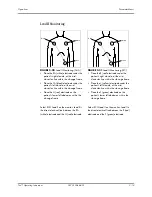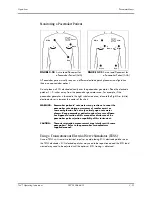
Trio™ Operating Instructions
0070-10-0666-01
2 - 15
Operations
Parameter Menus
NOTE:
Prepare the electrode site with alcohol only if the skin is
extremely greasy. If alcohol is used as a drying agent,
always allow the skin to dry before placing the electrode
patch on the skin.
2.4.1.2
Electrode Patch Location
NOTE:
Store electrode patches at room temperature and open just
prior to use.
NOTE:
Avoid more than one type of electrode on a patient because
of variations in electrical resistance.
NOTE:
Avoid placing electrode patches directly over bone
prominences or over any high activity movement areas such
as shoulders or arms because muscle motion produces
electrical activity. If an electrode patch is placed over a large
muscle such as the pectorals, the monitor may detect this
additional muscle activity and could lead to false
arrhythmia calls.
1.
To prevent evaporation of the contact gel medium, peel the backing off of the electrode
patch only when it is ready for use. Visually inspect the contact gel medium for
moistness. If the gel medium is not moist, do not use the electrode patch. Dry electrode
patches are not conductive.
NOTE:
If using the snap type electrode wires, attach the electrode
patch to the lead wire before placing patch on the patient.
2.
Attach the electrode patch to the skin at the prepared site. Smooth the electrode patch
down in a circular motion to ensure proper skin contact. If using soft gel electrodes,
never push down directly over the contact gel medium as this may displace the gel and
cause monitoring artifact. If using hard gel electrodes, it is recommended that during
application, the center of the electrode should be slightly pressed onto the skin to ensure
direct contact. Consult the electrode patch manufacturer’s instructions for specific use.
3.
Secure the lead wires to the patient according to hospital practice. For additional
information see section 2.4.1.3, “Lead Placement”.
WARNING: Ensure that the ECG lead wires are neatly secured in a
manner that will prevent them from encircling the patient’s
neck, creating a strangulation hazard.
NOTE:
It is recommended that electrode patches be changed at
least every 24 – 36 hours to maintain proper contact with
the skin. Some patients may require electrodes to be
changed more often. Electrode patches are disposable and
should be applied only once. Try to avoid reusing the exact
same electrode site during reapplication. If an electrode
becomes wet with fluid, change the electrode patch.






























